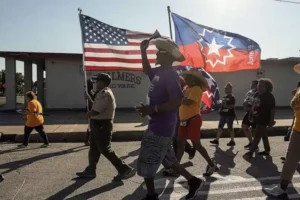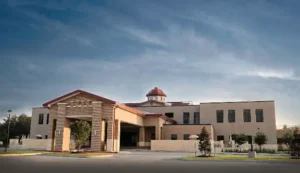CROCKETT – The Mary Allen Museum of African-American Art and History Board of Directors will be hosting its 2ndAnnual Mary Allen Founders Day Celebration on February 16 at Good Shepherd Fellowship Church located at 401 South 7thSt., Crockett 75835, starting at 1:00p.m. This year the community will meet and continue to raise the standard as previous museum presidents will be honored and the torch will be passed to the new Museum President, Dr. Thelma J. Douglass.

Dr. Thelma Douglass is a Fulbright Scholar. She served as the first Woman Vice President and first African-American Vice President of Student Affairs at Sam Houston State University; former Dean of Students at the University of Houston-Central campus; former Director of Student Housing at the University of Houston-Central Campus; Faculty Lecturer at University of Houston, Sam Houston State University and Vanderbilt University; taught at Crockett High School and is a Crockett High School Class of 1970 Alumna.
The Guest Speaker will be Reverend Henry Lovelady, Mr. Jim Tom Aimsworth will be speaking from the Presbyterian Perspective and African-American News & Issues’ Living Legend, Mrs. Johnnie Mae Brooks-Dale Thompson (93-year-old Mary Allen College Alumna, 1945) will also be speaking. Renown educator, Mrs. Roberta Mason will serve as the Mistress of Ceremony.
The 2ndAnnual Mary Allen Founders Day sponsors are: Moosehead Café owner, Mayor Joni Clonts, the Chuckwagon Café owner, Mrs. Regina Tillis and Pastor Leon Wallace of Good Shepherd Fellowship Church, Crockett.
For more information or details about the service call (936) 213-0363 or email Maryallenmuseum2018@gmail.com.
Mary Allen College History
The Mary Allen Seminary, a boarding school for African-American girls was founded as the Crockett Presbyterian Church Colored Sabbath School (1871-1875) and then became the Moffatt Parochial School. Reverend Samuel Fisher Tenney was active in the establishment of both schools.
In 1886 the Board of Missions for Freedmen of the Presbyterian Church begin planning for he establishment of a Black girls’ school in Texas. Rev. Tenney saw an advertisement referring to the project and immediately responded. The secretary to the Board of Missions for Freedmen, Rev. Richard Allen, was soon invited to Crockett. Prominent businessmen joined Rev. Tenney in receiving him.
After a statewide survey, Crockett was chosen as the school’s location-partly because of the country’s large African-American population and because of the Black parochial school that Rev. Tenney had previously founded. The community offered a grant of ten acres on a hilltop plot north of the city. Rev. Allen’s wife, Mary Esther, actively promoted the Texas boarding school for Colored girls and took on a key organizational fundraising role through the Women’s Executive Committee of the Board of Missions for Freedmen. When she died suddenly, the board agreed the official name of the school should be Mary Allen Seminary.

Mary Allen College received its name from the wife of Richard H. Allen.
Rev. J.B. Smith, a White man was commissioned to take charge of the new seminary, which opened on January 15, 1886. Mary Allen Hall, a four-story brick structure with basement, was completed on October 1, 1887. The school began as a day and boarding school offering courses at the primary, elementary, high school and teacher-training levels for girls only. Two years after opening, the school had an official June dedication.
Though only two years old, the seminary enrolled 152 pupils, 102 of whom were boarders. Those who had the opportunity to see its function were impressed with the religious influence pervading the seminary. On each morning the whole school was divided into four Bible classes, and an hour spent in close and systemic study of the Bible.
On every Sabbath morning from 9 to 10 o’clock the “Shorter Catechism” was studied. The dedicatory services took place on the afternoon of June 19. The chapel was too small to accommodate all who were expected to attend, and so an arbor was erected adjoining the chapel, under which 800 or 1000 colored people were seated by 3 o’clock in the afternoon. On the platform were assembled a number of the best White citizens of the place, who expressed a deep interest in the school’s work.
The exercises were commenced by a hymn sung by the girls, and beautifully sung it was. Rev. J. B. Smith, president of the seminary, then gave a short history of the school—its beginning two years ago last January with one scholar in an old hotel in the village, its rapid growth, the hard work they had in the old hotel, crowded with girls and no conveniences for their comfort, then of the gratitude they felt to the Christian women and Sabbath-schools of the North, when they were permitted to enter their new building. Then followed a solemn and touching prayer of dedication by Rev. Mr. Tenney, the pastor of the Southern Presbyterian Church, at Crockett, a warm friend of the seminary and of our work among the freedmen. A beautiful hymn of dedication was then sung by the girls, led by Miss Buttes, the teacher of music, and we wish all the women in our church could have heard that singing. We were then permitted to address the people, which we did with much pleasure and in the best manner of which we were capable, and were followed by an address from Colonel Nunn, a prominent lawyer of the town and once an officer in the Confederate army. The closing address was made by Rev. Mr. Tenney, and made a good impression on the audience, as we felt that every word came from a warm Christian heart. A chorus sung by the girl as only colored girls can sing, closed the afternoon service.
There was another dedication of the seminary previous to this of a unique but very touching character. Before the building was entirely finished a number of the girls asked permission of President Smith to go into one of the rooms and hold a little prayer-meeting. Permission being given, they went in and spent an hour in singing their weird plantation hymns and in prayer and thanksgiving to God, thanking him for their friends in the North who had built this house for them, and praying for his blessing on it When we heard this we felt there was no other dedication needed : these poor girls in the gratitude of their hearts had been before us, and we are sure that God had heard their prayers and accepted their humble thanksgivings; for,
“Richer by far was their hearts’ adoration, and dearer to God are the prayers of the poor.”
The day’s exercises were closed with an entertainment given by the girls in the evening at the chapel, consisting of essays, declarations, dialogues and singing. Some of the essays read would have done credit to the girls of any seminary in the land. Among the songs were a number of their plantation hymns, which were very beautiful and sung most impressively.
The house dedicated is only the main building; the wing in the original plan has not yet been built but is very much needed. Many pupils, the president informed us, will have to be turned away next term. Oh, that God would inspire the heart of some Christian lady or ladies to build this needed addition to the seminary!We congratulate the women and the Sabbath-school scholars of our church, and the individual friends of our work, on the founding of this seminary for the daughters of the poor colored people of the South. The good which it has accomplished and will accomplish cannot be estimated. It is a light in a dark land among a benighted people. The influence of it will be felt not only in time but in eternity.










